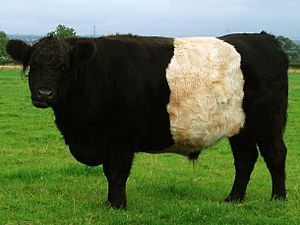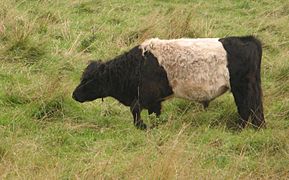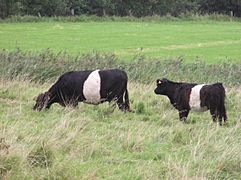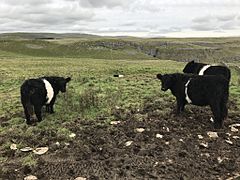Belted Galloway facts for kids

At pasture
|
|
| Conservation status |
|
|---|---|
| Other names |
|
| Country of origin | Scotland |
| Distribution | world-wide |
| Use |
|
| Traits | |
| Weight |
|
| Coat | black with broad white stripe around middle |
| Horn status | polled |
|
|
The Belted Galloway is a special type of beef cattle that comes from Scotland. These cows are easy to spot because they have a wide white stripe around their middle, like a belt! They are sometimes called "Belties" or even "Oreo cows" because of their unique look. Belted Galloways are very tough. They can live happily on rough, windy moorlands and upland pastures, which are areas with poor grass. This breed was officially recognized as its own type of cattle in 1921.
Belted Galloways are mostly raised for their excellent marbled beef. This means their meat has tiny streaks of fat that make it very tasty. Sometimes, people also keep them for their milk or just because they look so interesting!
Contents
Discovering Belted Galloway History
Where Did Belties Come From?
The Belted Galloway cattle come from the Galloway region in south-western Scotland. They are part of a larger group of traditional Scottish cattle breeds. Other famous Scottish cattle include the Aberdeen Angus and Highland breeds.
Most Galloway cattle are black, but they can come in other colors too. The white-belted or "white-middled" Galloway was one of these different color types. No one is completely sure how the white belt appeared. Some people think it might have happened when Dutch Lakenvelder cattle were mixed with Galloways a long time ago, around the 1600s. Lakenvelder cattle also have a similar white belt.
How the Breed Was Recognized
In 1852, both Aberdeen Angus and Galloway cattle could be listed in a special book called a herd-book. This book keeps track of purebred animals. Later, in 1878, a separate herd-book was created just for Galloway cattle.
In 1921, a group of farmers who raised these unique belted cows decided to form their own group. They called it the Dun and Belted Galloway Association. This group registered both belted and dun-colored Galloways. (Dun is a brownish-gray color.) Their first herd-book came out in 1922. In 1951, they stopped registering dun cattle, and the group changed its name to the Belted Galloway Society.
Belties Around the World
During the 1900s, Belted Galloways became popular in many countries. They were sent to places like Australia, Brazil, Canada, France, Germany, New Zealand, and the United States. New groups for Belted Galloway breeders started in New Zealand in 1948, in the US in 1951, and in Australia in 1975.
Recovering from Challenges
In 2001, there was a serious animal sickness called foot-and-mouth disease in the British Isles. Many Belted Galloways were lost during this time. But the breed has recovered well! By 2007, there were enough Belted Galloways that they were no longer considered an endangered breed by the Rare Breeds Survival Trust. The FAO also said they were "not at risk" that same year.
In 2012, there were about 3,500 registered breeding cows in the United Kingdom. In the United States, the American Livestock Breeds Conservancy now lists them as a "recovering" breed. This means their numbers are growing. About 18,390 Belted Galloways were registered in the US in 2015.
What Makes Belted Galloways Special?
Unique Appearance
One of the most interesting things about Galloway cattle is that they are naturally polled. This means they are born without horns! Their most noticeable features are their long, shaggy hair coat and that wide white belt that goes all the way around their body.
Their special coat helps them stay warm and dry. The rough outer layer sheds rain, and the soft inner layer keeps them insulated. This allows them to stay outside even in winter. While black Belties are the most common, you can also find Dun (brownish-gray) and Red Belted Galloways. Red ones are quite rare and highly sought after!
Registration Rules
To be officially registered in the Herd Book, a female Belted Galloway cannot have any white markings on her legs above the dewclaw (a small extra toe), except for her main white belt. For bulls, it's even stricter: they can only have the white belt and no other white markings on their body to be registered.
Genes and Colors
The dun color in Belted Galloways is caused by a small change in a gene called PMEL. This is the same gene that causes dun colors in Highland cattle. The black and red coat colors are controlled by another gene called MC1R, just like in most other cattle breeds.
Size and Temperament
Male Belted Galloways, called bulls, usually weigh between 750 and 1000 kilograms (about 1,650 to 2,200 pounds). Female Belted Galloways, called cows, typically weigh between 450 and 600 kilograms (about 990 to 1,320 pounds). When they are born, calves usually weigh around 30 kilograms (about 70 pounds).
Belted Galloways are generally known for being calm and gentle. However, mother cows are very protective of their calves and will guard them from anything they see as a threat.
Good for the Land
These cattle are great at eating rough grasses that other breeds might not touch. They can stay healthy and strong even on less-than-perfect pastures. They are also known for producing high-quality beef just by eating grass.
How Belted Galloways Are Used
Belted Galloways are mainly raised for their delicious beef. They are also sometimes used for vegetation management. This means they help keep fields and pastures healthy by eating unwanted plants. There's even an old type of Belted Galloway listed in the Ark of Taste by the Slow Food Foundation for Biodiversity. This list celebrates special foods and breeds that are important to protect.
Gallery
-
Belted Galloway in Nordfriesland
-
Belted Galloways in the Yorkshire Dales
-
A young belted galloway in Gloucestershire , UK.
See also
 In Spanish: Belted Galloway para niños
In Spanish: Belted Galloway para niños







